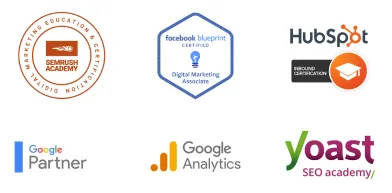TO LEARN IS TO GROW
Learning Center
We do our research and publish our results. Should probably call this the Growing Center.


12 Useful Tips on How To Write Better Blog Articles (For Your Business)
By now, you might already know that having a blog for your business is a good thing. For starters, businesses that do have a blog generate 126% more leads than those that don’t. And by having a blog on your website, you increase your chances of ranking higher in search by a whopping 434%!
Which is why many owners and online marketers are actively looking for tips, tricks, and hacks on how to write better blog articles for their business (or for whatever brand they’re managing).

It goes without saying that you should write about your area of expertise. But if you really want to write the best possible articles on your blog, you’ll have to do a lot better than that.
Sam Oh, who does digital marketing for AHREFs (and is also the familiar face in all their YouTube videos), says that creating a successful blog goes beyond just you.
“You should be a half-decent writer, (you should) understand the technical elements of blogging, as well as social strategies that can help you take your blog from nothing to something.”
What’s the gauge of a well-written blog article? A lot has been written about what makes a good blog post– it has to be comprehensive, market-relevant, and ultimately, helpful to your audience. Just as important, however, is your article’s ability to bring in traffic.
“The truth is that even if people are interested in what you’re writing about,” Oh explains, “it’s impossible for them to visit your site if they can’t find you. And even if they do find you, traffic is meaningless unless you can actually get them to read your content.”
With that in mind, here are twelve actionable tips you can use to write better articles for your business blog:
Becoming a Better Writer
First things first: let’s work on your ability to consistently come up with awesome content. Honing your craft to make better content will be your first priority. To be clear, when we say “better content”, we actually mean “content that actually ranks on Google”.
1. Focus on a specific part of your niche
Instead of taking a broad, general approach to creating content, focus instead on a particular niche. By focusing on a niche, you can better stand out to visitors who are specifically looking for your topic.
So, for instance, you might have a company that’s into outdoor recreational activities. Instead of having to blog about all kinds of things you can do in the great outdoors, you might choose to zero in on one particular activity, such as RV camping.
This approach also helps differentiate you from everybody else in the space. So rather than be a jack-of-all-trades, you can instead become the go-to resource for that particular niche topic.
2. Create content that's worth referencing
Another way to really set yourself apart from the rest is to create content that’s worth referencing. In the world of blogging, when others cite you as a reference, you earn backlinks. And backlinks, as you know, is one of the two top SEO ranking factors for Google.
What this means is this: the more reference-worthy content you create, the more backlinks you earn, and the more your SEO rankings get a boost.
How do you create content that’s worth referencing?
Develop content that’s unique and interesting to your industry. For this reason, coming up with case studies, infographics, whitepapers, academic papers, and state-of-the-industry reports all help achieve this goal.
Include statistics. As other people also blog and create their own articles, they too would want to provide supporting facts and figures to back up their claims. For this reason, sites like Oh’s AHREFs, Brian Dean’s Backlinko, Rand Fishkin’s MOZ, and Tim Chen’s Nerdwallet all regularly draw in links by regularly publishing stats and results from their own research.
Include unique images that are worth stealing. Getting stock photos online is easy. Actually making your own graphics– that takes a great deal of effort, but it’s well worth it. Illustrations also make for great link magnets, especially if it does a good job of explaining complex concepts or ideas.
3. Make your posts easy to read
When you’re blogging, you want to make your posts easy for people to process. After all– no one wants to read big blocks of text.
You’ll want to at least break down your articles into short, easy-to-read paragraphs. Break up long sentences when you see them. And use multimedia from time to time such as images and video.
Finally, you’ll want to write in a more conversational tone. Rather than sound too academic, too formal, or just too stiff, you want to come across as a lot more real and relatable.

4. Write click-worthy headlines
A good headline helps sell your article. Imagine your blog post listed on a search engine results page among several other similar articles.
Guess which one people will be likely to click. Among several similar posts on the same topic, the one with the most compelling headline gets the most clicks.
In coming up with an awesome headline, it’s a balance between setting the right expectations, including your main keyword and throwing in the right mix of creativity and wit.
5. Write a proper introduction
Getting visitors to click on your headline is one thing. Keeping them hooked enough to read the rest of your piece– that’s something else.
Sam Oh describes a process they use at AHREFs called the APP method, which stands for “Align, Present, and Proof”.

You can do this in just a few quick sentences. First off, you need to align yourself with the reader’s problem.
Then you present your post or position it to be the solution to that problem. You can even go ahead and give a quick answer or a summary right here.
Lastly, finish off your introduction with some proof as to why the readers should trust you or at least continue reading.
6. Create feedback loops
You might think you’ve come up with an amazing enough article. In all likelihood, it might be just that– but no matter how great you think you are as a writer, you can always benefit from the right kind of feedback.
Ideally, you’d have a team to work with: an editor to go through your post to check if, say, some fact-checking is needed, or an additional section is required to improve the flow. But even if you don’t have a team, you can still work with other bloggers or professionals within your space (see #10 below).
By getting a fresh set of eyes to look at your work, you should be better able to cover the gaps in your piece, if there are any. Or perhaps even elevate it in a way you haven’t previously thought of before.
Technical Aspects of Blogging
Honing your craft will certainly make you a cut above the rest. Working on the technical aspects of blogging and content creation allows you to take the next step in improving the blog articles for your business.
7. Write about topics people are actually searching for
Folks, this is where your keyword research comes in. Remember that 51% of all website traffic comes from organic search. So, if you want a piece of that action, you’ll have to quickly figure out which topics or subject matters are actually gaining a significant amount of search volume.
Keywords, key phrases, or topic clusters with a good enough search volume means there are enough people (at any given time) online looking at these.
Specifically, we’re looking to gain more traction for high-intent keywords. As opposed to someone looking for “best diesel engine for my truck”, you’ll prefer those looking for “best ford diesel engine shop near me” or “where to get ford diesel engine deals”, as these are people most likely ready to buy something (rather than just shop around or do research).
Some of our favorite keyword research tools include:
We’ll likely cover the topic of keyword research in another article, but the short of it is: you’ll want to initially cover low-competition (but still fairly high-demand) keywords or key phrases so you can rank for those easily. Once you’ve covered a good number of those, you can then steadily work your way up to slightly more competitive phrases or topics. And so on.
8. Cover your competitor's best topics
Another useful tactic to come up with better blog topics is to figure out which of your competitor’s posts or articles have been consistently bringing them traffic.
There are a good number of tools available to help you give a sneak peek at your competition’s best-performing blogs posts:
By using these tools, you can find out which topics have yielded excellent traffic for your competitors. Now that you know, all you have to do is come up with something better, more comprehensive, more market-relevant, or more helpful.
This is actually the essence of Brian Dean’s Skyscraper Technique: find out what ranks for your competition, create something better, then promote that content.
9. Do some basic on-page SEO
This is another section that warrants its own article. In a nutshell, however, on-page SEO refers to the adjustments you do on web pages to help them rank higher in search engines.
Without going too much into detail, here are a few key tips that help make any given page on your website a lot more search-engine friendly:
Use your keyword within the first 100 words of your article.
Use short URLs.
Include your primary keyword in that short URL.
Use your keyword at the beginning of your title tag.
Use your keywords on your H1, H2, and H3 tags.
Use LSI (latent semantic indexing) keywords by writing naturally. (It helps Google give better context to what you’re really writing about.)
Publish long-form content. (Longer content is likely more comprehensive. Plus, it has more LSI keywords!)
Break your content into chunks. (Use shorter paragraphs and shorter sentences. Use headings and subheadings.)
Use multimedia. (Particularly screenshots, video, and charts.)
Optimize your title tag and meta description or better CTRs (click-through rates) (Two random tips: use parentheses/brackets and use numbers).
External links: link out to two to five authoritative sources for each article.
Internal links: link to two to five of your site’s older pages which you want to rank.
Maximize page speed (by compressing your photos, using a CDM, investing in premium hosting, etc.)
Keep your content up-to-date.
Double down on content formats that work (specifically– “why” posts, “what” posts, and infographics.)
Getting Social
To really push your business blog to the next level, work on some of these action items that focus on relationship-building with other folks online.
10. Connect with other bloggers
Consider forging relationships with other bloggers within your space. There’s a reason why it seems all the big players are in the same circle of friends– when they weren’t big yet, they’ve already been hanging out together.
So you’ll want to make friends with these bloggers. Understandably, not everyone might want to be friends. But the smarter ones who realize the value of doing so will certainly want to connect. Like-minded bloggers will welcome the opportunity to offer (and receive) feedback and help, and even cross-promote content with you.
11. Build an email list
An email list is a great way to get visitors to your blog to keep coming back. You’ve been publishing incredibly helpful content all this time, anyway. So at the very least, your emails serve to let your readers know you have new content available.
So remember: build your email list from day one and keep on nurturing those subscribers. Subscribers are a step above cold traffic and first-time visitors. In terms of engagement, they’re more likely to interact with your content, share it on social, link back to you, and patronize your brand’s products and services.
12. Promote your online content in online communities
Without being too spammy, you’ll want your links to somehow show up in online communities like Facebook Groups, Reddit, Quora, LinkedIn, and so on.
This is certainly going to be challenging; you’ll likely be investing quite a bit of time to naturally integrate into these communities. As you become a more recognizable name and face, and as you see a real need for it, you can share your content that helps solve other community members’ problems.
Growing Businesses Since 2008
We have helped hundreds of businesses just like yours. Working for or along-side of business owner, managers, staff, or even board of directors, LOJO is ready to be an asset to your business.
Our team has been curated through the years for individual skills, personalities, and capabilities. Our clients put their trust in us to help them grow. We are here to do just that.



Growing Businesses Since 2008
We have helped hundreds of businesses just like yours. Working for or along-side of business owner, managers, staff, or even board of directors, LOJO is ready to be an asset to your business.
Our team has been curated through the years for individual skills, personalities, and capabilities. Our clients put their trust in us to help them grow. We are here to do just that.




Matthew Rogers, President
iProspect Check
After spending several months reviewing multiple proposals from several different companies we engaged LOJO to develop a new website that represents our company effectively. We worked initially with Stephen Platte who helped create the scope of the project. Stephen was knowledgeable and always followed up with me on time and as promised.
He "closed the deal" for LOJO with his professionalism, service orientation and easy going approach. Once we signed the contract we were introduced to Jay Kelly who would be the creative lead for LOJO. This was the most challenging part of the project for my company, as there was no shortage of ideas from our side. Jay managed the project flawlessly, and once we had all agreed to the design, Jay introduced us to Eric.
Eric Lay is one of the founders of LOJO. Eric took the design we had developed and brought it to life. We delivered content as quickly as he requested it. Eric kept the project on task and we responded by exceeding every deadline for content. In turn, once provided, literally not a day went by that Eric didn't add the content and take the next step. In just a few weeks we launched our new website. Eric is a pleasure to work with.
His positive attitude and consultative approach really enhanced the experience and made a big difference for us in the outcome of our project. We would welcome you to visit our website to take a look at the quality work of LOJO. We are very pleased with LOJO and look forward to working with them in the future as we pursue an aggressive SEO strategy."
After spending several months reviewing multiple proposals from several different companies we engaged LOJO to develop a new website that represents our company effectively. We worked initially with Stephen Platte who helped create the scope of the project. Stephen was knowledgeable and always followed up with me on time and as promised.
He "closed the deal" for LOJO with his professionalism, service orientation and easy going approach. Once we signed the contract we were introduced to Jay Kelly who would be the creative lead for LOJO. This was the most challenging part of the project for my company, as there was no shortage of ideas from our side. Jay managed the project flawlessly, and once we had all agreed to the design, Jay introduced us to Eric.
Eric Lay is one of the founders of LOJO. Eric took the design we had developed and brought it to life. We delivered content as quickly as he requested it. Eric kept the project on task and we responded by exceeding every deadline for content. In turn, once provided, literally not a day went by that Eric didn't add the content and take the next step. In just a few weeks we launched our new website. Eric is a pleasure to work with.
His positive attitude and consultative approach really enhanced the experience and made a big difference for us in the outcome of our project. We would welcome you to visit our website to take a look at the quality work of LOJO. We are very pleased with LOJO and look forward to working with them in the future as we pursue an aggressive SEO strategy."

Matthew Rogers, President
iProspect Check
The team at LOJO were wonderful to work with. They are well organized and very patient as we worked through our marketing strategy and developed a well thought out and clear action plan at a reasonable price. We will definitely be back for our future campaign needs."

Jon Crosby, Founder
Dazil

